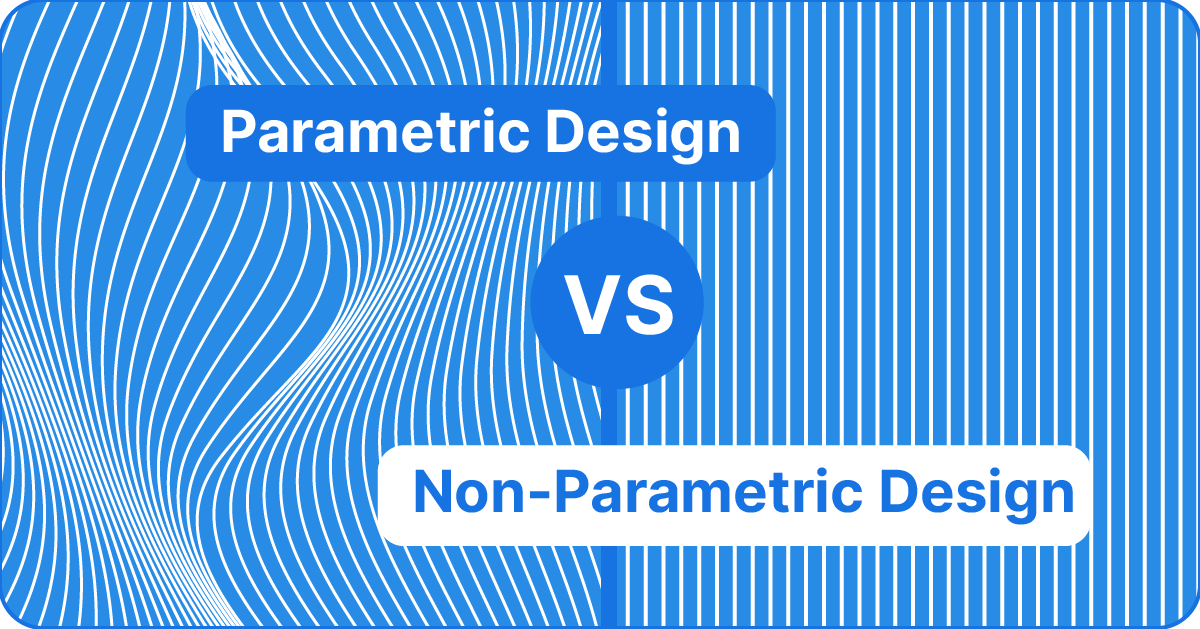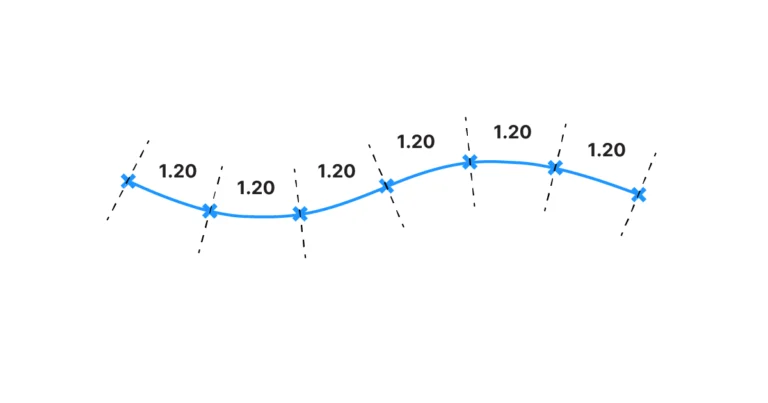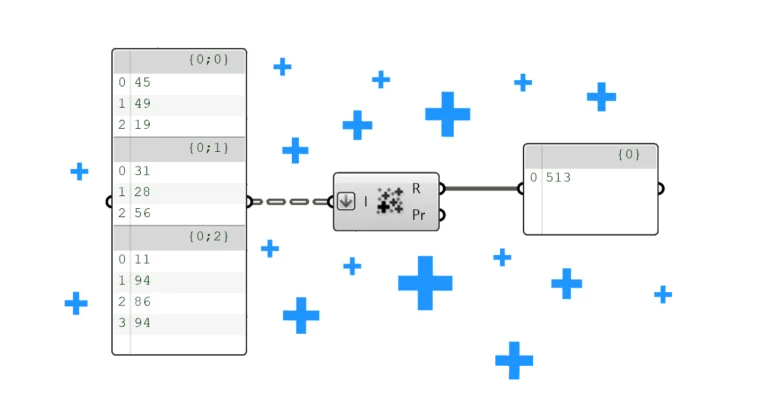In the world of design, the debate between parametric design vs nonparametric design continues to shape discussions about innovation, efficiency, and aesthetics.
The parametric approach leverages computational power to craft flexible and adaptable designs. Conversely, nonparametric design cherishes tradition, focusing on the intentional, unique crafting of each design feature.
In this article, we’ll take a closer look at both to assess how do they stack up when it comes to creating outstanding architecture today. We’ll look at the strengths and weaknesses of both and learn which contexts they each shine in.
Let’s get started!
Understanding Parametric Design
As a design approach, Parametric design refers to a design that is derived from a set of parameters defined by the designer. These parameters drive the entire design, and every element in the design is subordinate to them. If the parameter is the flow of people for example, the entire building’s shape can follow a network of optimized routes. These parameters can define the design’s organization, its formal language all the way to the façade and even detailing.
This design approach is called parametricism. Started around 2010 and brought to international attention by the late Zaha Hadid and put into a theoretical framework by Patrick Schumacher (former partner at Zaha Hadid Architects). Parametricism claims that only the parametric design method can solve the increasingly complex, data-laden design problems of today.
But not all parametric architecture is based on this conceptual view and many architecture studios instead simply consider parametric design a design tool.
Parametric design is created with CAD software, that allows designers to describe designs in terms of how geometric parts relate to each other. Most CAD software today offers some kind of parametric design capability. The most popular software among leading architecture firms is Rhino and Grasshopper.
As a design tool, parametric design focuses on the relationship between elements. In a way, a parametric designer designs the relationship between objects instead of the objects themselves.
Parametric modelling is therefore a paradigm shift from manual modelling, where the relationship between elements is static, and definitive, and crafted by the designer.
As a consequence, parametric designs are infinitely more flexible. Changes to the parameters, for example the extent of a twist of a high-rise, can be done instantly. This feature alone undoubtedly tips the parametric design vs nonparametric design debate in favor of the former.
Advantages of Parametric Design
- Flexibility – Parametric designs are infinitely more flexible. Changes to the parameters update the final design instantly. Once a model has been set up, making changes anywhere in the design is simply done by adjusting a parameter.
- Speed – parametric modelling is potentially a time-saving when it comes to design adaptations. Several design iterations can be produced and evaluate quickly.
- Precision – parametric design allows architects to define, tweak, and control every aspect of the design with great detail. This accuracy is not just limited to initial stages, but can be maintained throughout the project lifecycle, ensuring consistency in design execution.
Challenges in Parametric Design
- Repetition – Many designs created with parametric tools end up looking the same. This is largely due to the fact that architects lack programming training. And without knowledge of how to create original scripts they have to rely on an established set of algorithms.
- Limited to preset parameters – While within a script, the parameters can be modified freely, the description of the relationship of the elements in the design – in other words the script, is still static. Adjusting the parameters alone will therefore yes, lead to an infinite number of options, but only within a narrow design scope, potentially limiting the design freedom.
- Dependency on technology: Parametric design is highly dependent on specific software – which makes it vulnerable to compatibility issues and software bugs.
Understanding Nonparametric Design
Contrasting with parametric design, in non-parametric design the architect’s imagination takes center stage. Design features are intentionally and specifically crafted by the designer as opposed to resulting from of a computationally driven process.
The focus here is on the artistry and human ingenuity in design, resulting in a space for the designer’s signature style to manifest freely. This approach fosters a sense of originality and individuality in each project, leading to designs that carry an unmistakable imprint of their creator.
Before modern computational tools and software, everything was non-parametric design. Architects relied on manual drafting and their individual creativity to shape their designs. They drew on their understanding of materials, cultural contexts, and user needs to build unique and purposeful spaces. Today, nonparametric design acknowledges that while technology has a significant role in modern architecture, the human touch remains an invaluable aspect of the design process.
As for the tools and techniques employed in nonparametric design, they range from manual sketching to computer-aided design (CAD) software. However, unlike in parametric design where the software is used to determine the design, in nonparametric design, CAD serves merely as a tool to document and visualize the designer’s ideas. Nonparametric design doesn’t use algorithms to generate design forms. Instead, it capitalizes on the designer’s expertise, intuition, and creativity to bring unique and tailored solutions to life.
Advantages of Nonparametric Design
- Creativity – there are no limits to what a non-parametric design can look like. Designers can use artistic, historical, philosophical or pragmatical ideas and turn them into a design with whichever tools they want. Historically, tools come and go, but human ingenuity always finds new ways to create innovative design approaches.
- Software independent – non-parametric design doesn’t rely on any predefined sets of software or tools. Choosing the tools that can best turn an idea into a design results in high quality designs.
- Artistic – disconnected from the algorithmic and number-driven underpinnings of parametric design, the artistry and aesthetic sensibility of the designer takes center stage. Architecture has been a deeply artistic, cultural part of societies and non-parametric design cherishes that lineage.
Challenges in Nonparametric Design
- No Flexibility– non-parametric design involve a high amount of crafting by the designers. The freedom of designing every element according to the designers vision comes at the cost of flexibility. Once designed, changes are difficult to implement and require a redrafting.
- Lower Precision – non-parametric design doesn’t make use of computational precision and accuracy. Human judgement and human oversight can lead to a lower degree of precision in the way parts come together in the design.
- Time consuming – non-parametric designs are crafted element by element, whereas in a parametric design multiple, varied elements can be generated effortlessly. Consequently, time efficiency is lower in comparison.
- A Contemporary Method? – Architecture and design are always closely related to the zeitgeist and the challenges of the present. One could argue that not using the potential of parametric tools is equivalent to not keeping up with the times.
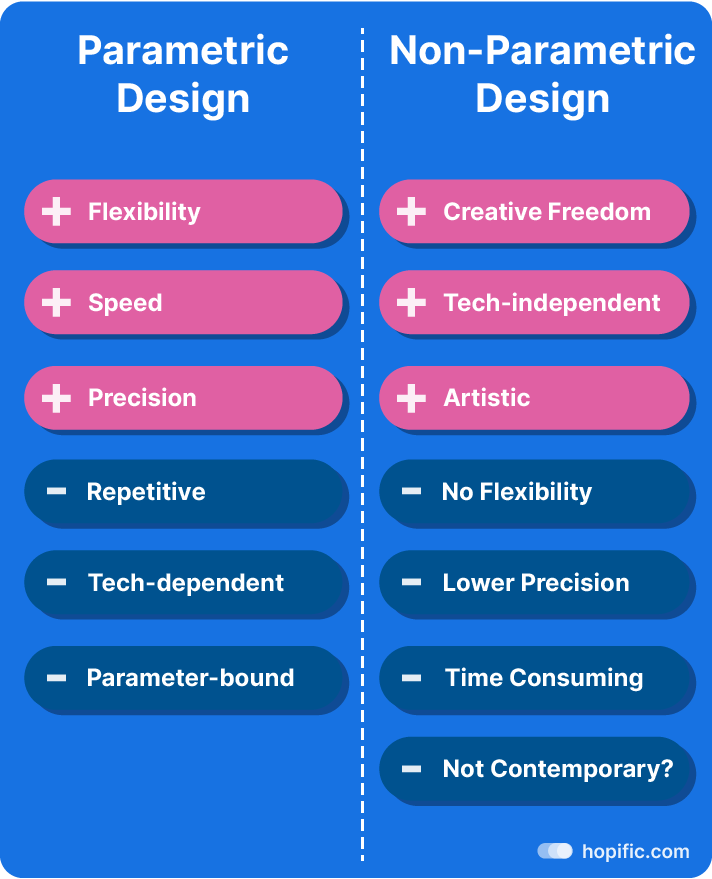
Parametric Vs. Nonparametric Design: A Comparison
Now that we have a deeper understanding of what parametric and non-parametric design is, and we’ve considered the benefits and drawbacks of both, let’s compare them in terms of design quality.
Of course, design quality is not an objective measure, and it would be pointless to argue that one design method is better than another, but there are differences between the two that are worth highlighting.
When comparing parametric design vs nonparametric design, we first need to consider design holistically.
The Primacy of the Design Idea: Unpacking the True Heart of Outstanding Architecture
When it comes to design, what reigns supreme above all else, is the design idea. An original design idea is what captivates people’s imagination, makes a design instantly understandable, and, in the best case, leads to a coherent, aesthetically pleasing formal expression.
Let’s take the Sydney Opera House by Jørn Utzon for example. One of the world’s most iconic buildings, the Sydney Opera House, exemplifies a strong design idea guiding form. Architect Jørn Utzon’s winning design was based on the concept of creating a sculptural, artistic structure. He sought to mimic the sails of the numerous yachts in the Sydney Harbor, resulting in the building’s distinct, shell-like structures. These sweeping, sail-like forms have become a symbol for the city and the nation.
A bold idea spearheads any outstanding design. Consequently, the choice of methodology (i.e. parametric design vs nonparametric design) naturally assumes a secondary role in the design process.
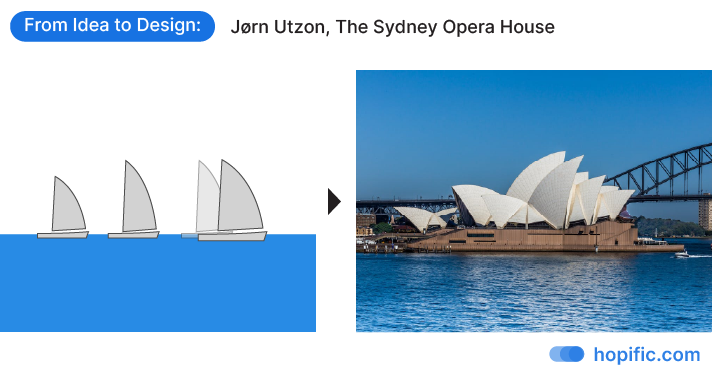
Parametric Design as a Design Concept
This doesn’t mean however, that parametric design can’t be the leading idea behind a project. Some design concepts heavily lean on the interplay of streams of people, synergies of functions and environmental design optimization. Using parametric design tools in that case can help solve complex geometric problems, and lead to a formal expression that would be impossible to achieve with traditional methods.
In that case, the concept and the design tools are in harmony. The idea comes to life in the final design by leveraging the computational power of parametric design.
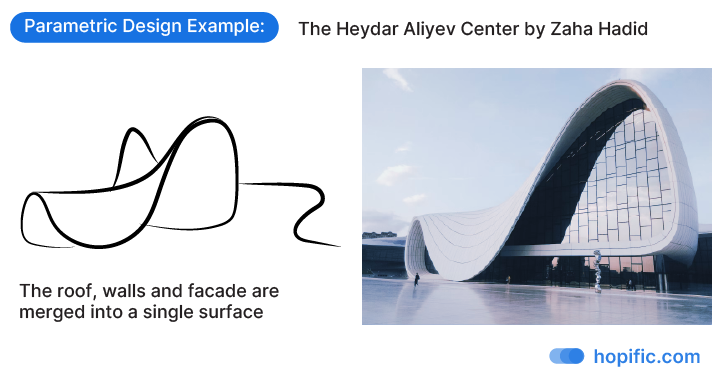
The issue when using parametric design as the core design idea and then bringing that idea to life with the help of parametric design tools, is that all the resulting design shares the same DNA. This can be a problem in a field where originality and innovative thinking are held in high regard.
Non-parametric design doesn’t have this problem. Since the conceptual starting point as well as the design tools can be chosen freely, the resulting architecture is almost never the same, leading, in the best case, to completely unique and original designs.
Parametric Design as a Tool
One could argue that stripped of its philosophical foundation, parametric design is a design tool as opposed to a design idea.
And when used as a tool, it doesn’t need to lead to a particular formal or visual language. Parametric tools can be used to aid in the design of a, at the core, non-parametric design. The tools can save time and make the design process more efficient, without leading to a result that is visually ‘parametric’.
But this takes a lot of control. Using parametric tools can lead the designers hand into a visual language that was not originally intended. There is a risk of letting the tool dictate the design output, curtailing the creative control of the designer.
Therefore, when using parametric tools, its important to stay focused on what the design intention is instead of being led astray by the algorithmic allure that the tool creates.
Conversely, sometimes designs have recognizable parametric design features, like gradients or smooth transitions, but at the core the architecture follows a conventional design idea. In that case parametric design has been reduced to a formal language, leading in most cases to poor results.
The Future of Architectural Design: Will Parametric Overcome Nonparametric?
In the past decade, Parametric design has moved away from the idea of an all-encompassing parametricism. It has become more specific and subtle. Architects employ it as a design tool strategically and refrain from using it just to show off its underlying computational source. The ‘smartness’ of parametric design has been integrated into the building design instead of merely being used as a eye-catching veneer.
After a brief moment of ‘method-lead’ design in the 2010s, the design idea has reclaimed the top spot in the pecking order of the design process. In addition sustainability challenges have shifted the discussion from parametric design vs nonparametric design to performative metrics of design.
Today, parametric modelling tools have become a powerful addition to a designer’s toolset. It expands the designer’s formal vocabulary and offers a way to overcome the challenges of complex geometry, efficiency, and sustainability.
Parametric design is used to reinforce, bolden and sharpen architectural concepts. It will, moving forward, be an indispensable tool for dealing with the complex design tasks of our world. And not using them would mean leaving valuable resources and opportunities on the table.
The Bottom Line
In conclusion, both parametric and non-parametric design methods offer unique advantages and insights to the field of architectural design. Parametric design, with its precision, flexibility, and ability to manage complex geometric relationships, presents a powerful tool for dealing with the complex challenges of modern design. On the other hand, non-parametric design emphasizes individuality, originality, and the power of the design idea. It serves as a testament to the human creative spirit and its capacity to shape our built environment in a meaningful way.
However, the paramount takeaway from this exploration is the reaffirmation that the design idea reigns supreme. Regardless of the methods used in the creation process, the design concept or idea is the cornerstone that captivates the imagination, shapes understanding, and determines aesthetic impact.
Ultimately, the choice between parametric and non-parametric design shouldn’t be a binary one. Instead, architects and designers should view them as complementary tools in their arsenal. Each is capable of enhancing their creative vision when used appropriately. As design continues to evolve in the face of emerging technologies and changing societal needs, embracing the strengths of both approaches will be key to pushing the boundaries of what is possible in architectural design.
So, in summary, who wins in the battle of Parametric design vs nonparametric design?
Perhaps the question is ill-posed: the design comes first, and whether it is produced parametrically or not, is secondary.

